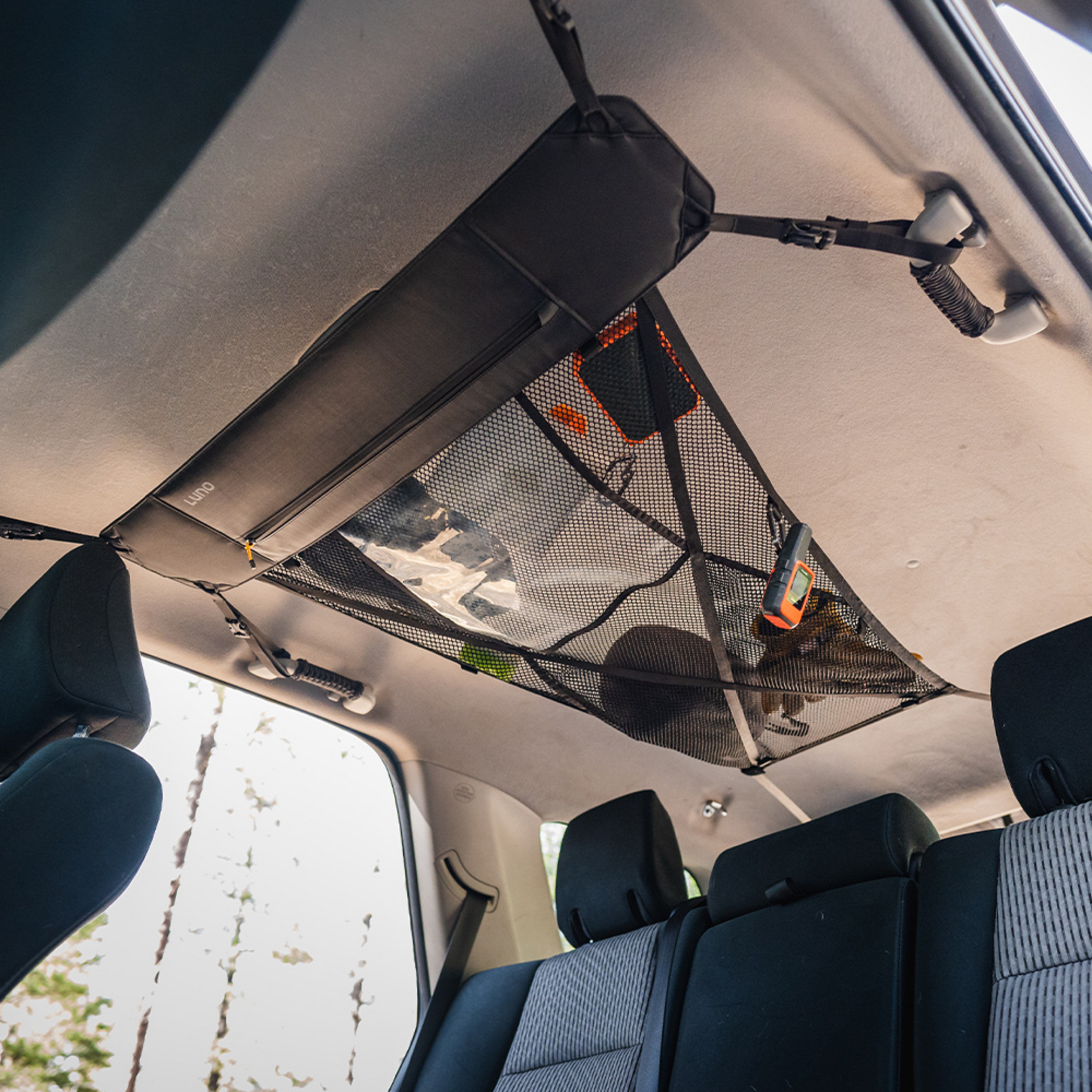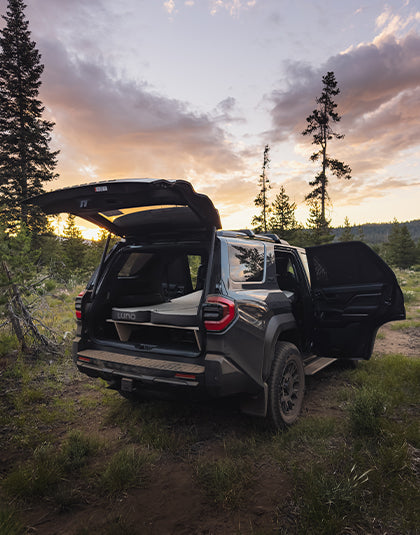
Driver’s Shred #3: How To Turn Your Car, Truck, or Van Into the Ultimate Climbing Base Camp
Welcome to our new series, Driver’s Shred, where we help Luno community members turn everyday cars, vans, and trucks into bad-ass adventure mobiles. Each Driver’s Shred article will focus on tips, tricks, and gear recommendations that enable you to camp comfortably while crushing a specific sport or activity. Simply put, our mission is to help you camp, shred, and repeat. So grab your pens and pencils, because class is in session—and this time around, our focus is on climbing.
Although many rock climbers are self-proclaimed “dirtbags,” and wear the badge with honor, fans of rock and rope have enjoyed this way of life long before vanlife was a hashtag. Camping out in parking lots, a carabiner’s throw away from your favorite crags has many advantages. If you want to crush climbing objectives for days on end, there’s no better way to maximize your fun over the weekend than to camp close to the crag.
Looking to get in on the action? You’re in the right place. No matter if you’re a boulderer or an alpinist, in this month’s Driver’s Shred, we’ll be dishing up beta that’ll help you car camp comfortably, safely, and in style on your next climbing trip.

1. Train Ahead of Your Trip
Going on a climbing trip when you’re out of shape is a recipe for disappointment (if not disaster). During the months and weeks leading up to your trip, make sure you’re hitting the gym and your local crag accordingly. Even if you’re a casual climber, you’ll enjoy your travels much more if you’re in decent shape. Here are a few tips to keep in mind as you develop your fitness.
- Be discerning with route choice. If you’re going somewhere with a particular style of climbing–say, Indian Creek for crack climbing–do your best to find routes with similar holds. If you’re climbing multi-pitch routes for the first time, work on endurance, lapping routes with your partner at the gym. If you’re heading to a bouldering zone famous for its overhung, juggy problems, it doesn’t make much sense to work on crimpy sport routes at the gym. Be strategic!
- The gym is your friend. While climbing is certainly more fun than working out, don’t be afraid to hit the gym and pinpoint things like cardio, core strength, grip strength, etc.
- Train like the pros. If you’re looking for a professional, scientific approach to climbing fitness, check out this yearly training plan from pro climbing coach Neil Gresham.
- Don’t overtrain. It’s tough to find the sweet spot, but ideally, you’re both in extremely good shape and well-rested before your climbing trip. Just like marathon runners taper down before a big race, it’s not a bad idea to mellow out your climbing intensity in the days right before you leave. The last thing you want is an unwarranted injury because you were sending hard at the gym.
2. Practice Rope Skills
If you’re learning the ropes, practice skills in a safe setting well ahead of your trip. It can be a smart idea to hire a rock guide to get you confident with a certain skillset, like building anchors or placing trad gear. Even if you’re an experienced climber, it’s always a good idea to practice rope and safety skills ahead of your trip. Check out Alpine Savvy for some great educational resources or consider subscribing to Outside+ and watching this series taught by climbing legend Conrad Anker.

3. Do Your Research: The Belt and Suspenders Approach to Climbing Beta
Every climber knows the importance of beta. Researching a crag and specific routes ahead of your trip won’t just help you train and pack accordingly, it’ll also minimize the likelihood of climbing off route. Take screenshots and save them to your phone for reference, as most great climbing destinations don’t come with cell service.
Bring Guidebooks
While many swear by apps and online beta, it’s a great idea to bring a guidebook. Why? Guidebooks don’t have batteries, won’t break, and make for good reading the night before a day of climbing. Also, guidebooks supply photos, ratings, protection beta, and more indispensable info that you often can’t crush without.
Download Beta Ahead of Time
We like to take a “belt and suspenders” approach to climbing trips, bringing both a guidebook and the digital equivalent. On the app front, we recommend Mountain Project. Be sure to download the zone ahead of time, as you may not have service at remote crags. Gaia GPS is also good for navigating “offline” and checking things like snowmelt or smoke pollution before venturing out.

4. Pack Accordingly
We mentioned this above, but researching your destination will help you pack accordingly. If you’re going on a bouldering trip, you probably don’t need your trad gear, but an extra crash pad won’t hurt. It’s always a good idea to pack extra protection–if you lose or break gear, you want to be prepared for worst-case scenarios.
5. Stay Organized
Another important note on packing: staying organized will only make your trip easier and your climbing experience more enjoyable. Our go-to organization strategy for climbing gear? We often pack more gear than we need in an 80L Mesh Gear Duffle, then pack a backpack for each day based on the objective.
Three Luno Storage Solutions For Climbers of All Creeds
We also highly recommend the following Luno storage solutions for staying on top of your climbing and camping gear while on the road:
Our latest innovation in the storage department, the Cargo Hammock is an absolute game changer for climbing car campers. The mesh shelf is perfect for stashing bedding, clothes, and more, while the loops and straps can be helpful for everything from quickdraw storage to hanging headlamps.
The last thing you want after climbing a multi-pitch desert tower? Rank climbing shoes stinking up your vehicle. Our Gear & Shoe Storage bags use magnets to attach to the outside of your car, while the mesh bottom lets wet and sweaty kicks drip dry and air out overnight.
Think of the Seatback Organizer 2.0 as a nightstand for car camping. Replete with zipped pockets for your phone, keys, and other easy-to-lose gear, a headlamp stash pocket, and additional organizational features, it’s a handy helper and a welcome crutch on alpine starts.
6. Forget Crashing On Your Crash Pad
Some climbers swear by crashing on the crash pad, but most pads are too stiff to actually be comfortable. Also, even large, 4’ by 5’ crash pads are too small for comfy camping. We highly recommend you reserve the crash pad for climbing and campfire lounging, snoozing instead on a comfortable, rugged, easy-to-use Luno Air Mattress. We offer mattresses for SUVs and hatchbacks, 5-foot and 6-foot truck beds, even the front cab of popular van models.
7. Alpine Starts Are A Smart Play
One of the main reasons we love car camping in crag parking lots is that it makes alpine starts much easier. It’s simple to snooze in your car on a Luno Air Mattress, roll out of bed, and seize the day.
Why do we love an alpine start?
- Big objectives. If you’re tackling a multi-pitch route, alpine starts are often mission-critical. If you want to summit and descend in daylight, starting with a headlamp may be your only play.
- Crowded crags. If you’re hoping to get on a popular climb, especially on a weekend with decent weather, the early bird definitely gets the worm.
- Weather. In places like Colorado, summer thunderstorms are a real threat in the mountains, and these often hit in the afternoon. In addition to becoming self-taught weather meteorologists that can smell a storm from 100 miles away, climbers will check the weather and often attempt to be off the top by noon at the latest to avoid a chance run-in with Zeus and his thunderbolts.
8. Check for Permits
Permits are not necessary at many crags, but the last thing you want to do is drive hours to a crag only to realize you’re missing the necessary paperwork. If you’re going to a zone like California’s Yosemite or Colorado’s Garden of the Gods, be sure to get the permit dialed. Again, this point just stresses the importance of doing your research ahead of your trip.
9. Visit Local Outdoor Shops–and Local Shops in General
If you’re looking for a guidebook, local beta, a chalk refill, etc., stop by a local outdoor shop. Most popular climbing destinations will have a gear shop or two nearby, and their local knowledge is often indispensable.

In a similar vein, we always like to support other local establishments, too, from grocery stores and coffee shops to food trucks and bookstores. As travelers, contributing to a local economy is a great way to show appreciation for the community you’re passing through and the routes they maintain.
10. Respect the Locals
Speaking of the locals, we can’t overstress the importance of crag etiquette. Nothing turns a climbing community off from welcoming visitors like pumping speakers and buzzing drones. Be respectful to the locals and leave the distractions at home. Also, this one goes without saying, but pick up after your crew and Leave No Trace.
Preparation Is Key
Climbing without safety precautions is a dangerous activity, but when you’re diligent about planning, prep, and safety, even challenging routes become a straightforward affair. Similarly, car camping can be extremely overwhelming without taking certain precautions, but with a little prep work, it becomes second nature. We hope this edition of Driver’s Shred helps you mentally prepare for and embark upon a climbing adventure of a lifetime. Who knows? Maybe we’ll see you at the crag.
Thanks for reading, and see you on the road,
The Luno Crew











